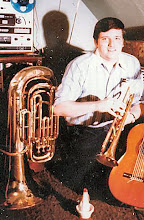

PETE FOUNTAIN'S NEW ORLEANS
Clarinet Solos with Rhythm Accompaniment
No matter how far upstream jazz may have come from New Orleans, there exists a nostalgia, in some cases a reverence, in most minds, for that early cradle of American music. And, as a general rule, New Orleans musicians help to perpetuate that nostalgia and reverence. They live on streets with wonderful names. They study in time-honored tradition. They begin their professional lives in a flamboyant manner. Then they work on other streets with even more wonderful names. And, at least since that first wave or two, which went to Chicago, they just never want to leave home.
Pete Fountain is a New Orleans musician and he fits that pattern in a manner almost too good to be true.
Born there in 1930 (July 3rd), he studied clarinet with Mr. Allessandra of the New Orleans Symphony. Although he played jazz during those early years, it wasn't until he was nineteen that he worked his first professional jazz job. "It was the night that Fazola died. They needed someone to substitute for him, so I took his job in a strip place." That was an odd coincidence, because Irving Fazola, another New Orleans musician who didn't like to leave home, and Benny Goodman were the two greatest influences on Fountain ("my two real idols") , and they still are, as is evident in his playing.
"I had to lie about my age to get that job. After a little while the management found out and fired me, so I started gigging around the city, anywhere I could work."
Then, several years ago, Pete did leave New Orleans, and Lawrence Welk confused his listeners and watchers somewhat by hiring Pete as a soloist, presenting him once an evening with a small unit from the band in some jazz selection.
This viewer at least (and I have always been a steady customer, because the Lawrence Welk program is continually the best comedy show on television) was disturbed by Welk's perpetuation of the age-old legend that jazzmen couldn't read music. He even apologized to his audience in that way one evening, in explaining away Pete's seeming inactivity during most of the band numbers. But audience reaction was enthusiastic and Pete gratefully acknowledges the debt which he owes to Welk for his current jazz success.
In 1957, I finally had the opportunity to hear Fountain without Welk, when he sat-in with the Bobby Hackett sextet in the Voyageur Room. He was already beginning to feel the pinch of once-a-week jazz, and his enthusiasm that night was contagious, and so was his playing.
Perhaps that was the breaking point, for, although he stayed with Welk for a year after that, he had begun to collect train, bus and plane schedules from anywhere to New Orleans.
This year the urge became too strong and back he went. Now he lives on Annunciation Street and works in a club called the Bateau Lounge on Bourbon Street (what did I tell you about those names?).
He has "a small interest in that club. Hey, you know what, we play six hours a night, and the place is packed from nine until one practically every night. You know that puts a little bread on the table" (all of this in less of a Southern accent than has Shorty Rogers).
During the day he's still studying: "There's always so much more to learn." But at night, for six hours, with just a rhythm section, he makes the bread that goes on the table, believing that by the time that all the publicity from the Welk show comes to an end, he may be lucky enough to have built a sufficient reputation of his own.
"There's still quite a bit of jazz in New Orleans, you know. In proportion, we probably have more than you have in New York City. We certainly have more than in Los Angeles. On Bourbon Street alone, there's seven Dixieland bands. Plus me. You know, me and the rhythm. We just swing away."
That, this album will show. With pianist Stan Wrightsman, bassist Morty Corb and drummer Jack Sperling, all of them free-wheeling swingers, Pete demonstrates what has been a long time developing in this guided tour through his musical life - that Pete Fountain is a wonderful clarinetist, a member of that old school of warm, personally communicative musicians whose playing denies a dateline. What can be heard here is an excellent musician, accompanied by other excellent musicians, playing songs that are as familiar as the seasons of the year, allowing talent and artistry to grace each with that pleasant freshness that each season brings.
But now I am getting carried away by words, and the temptation is strong to close with some play on his name, such a wonderful one for a jazz musician. I thought for the moment that such a working of his name into the album title would be especially fitting. But Pete Fountain's New Orleans is probably the best name that there could be for this collection. If You Know What It Means to Miss New Orleans, you'll know how happy he is to be back. And this is the eminently satisfying music of a happy man.
Bill Coss




No comments:
Post a Comment